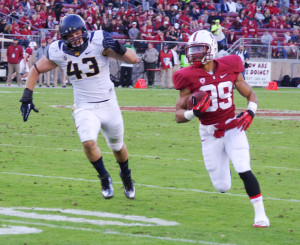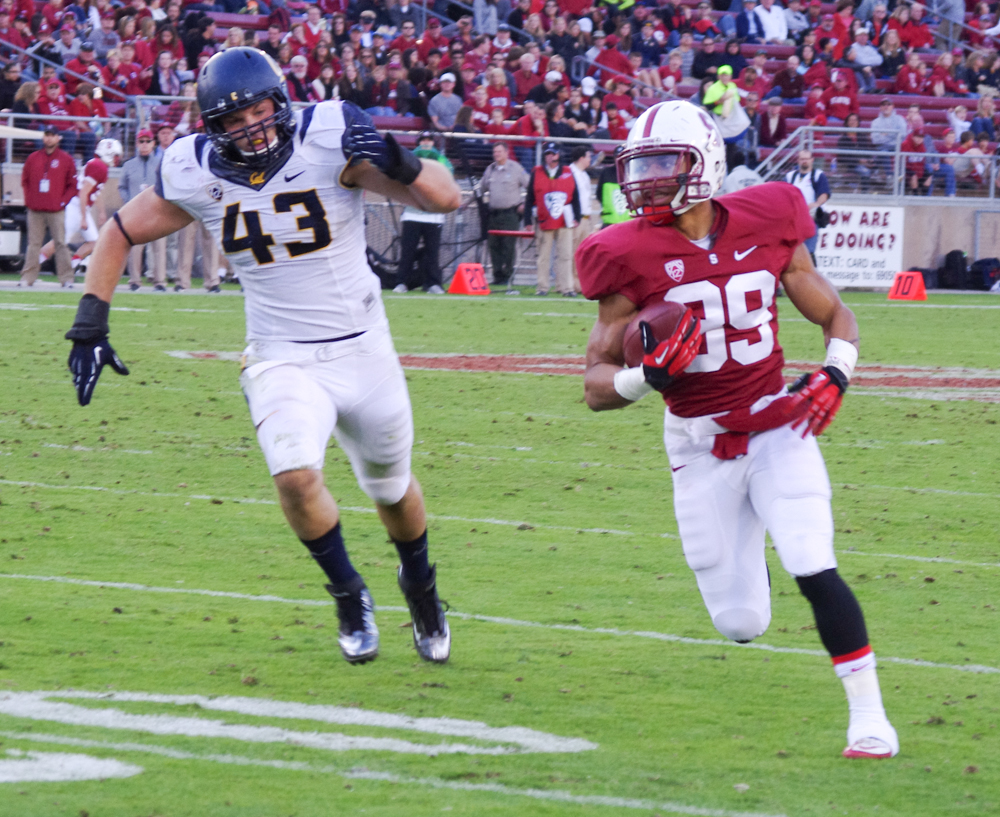Three hundred and thirty carries for 1,709 yards and 21 touchdowns.
That’s what the Stanford Cardinal will be looking to replace in its running game heading into 2014 with the departure of senior tailback Tyler Gaffney, presumably to the NFL. But don’t think for a second that having to do so is unfamiliar to the Cardinal by any means, given that it has seemingly had this exact problem twice in the last half-decade.

Following the 2009 season, the team lost almost 2,000 yards of rushing when Toby Gerhart ‘09 was drafted by the Minnesota Vikings. When that happened, Stepfan Taylor ‘13 stepped up and became Stanford’s all-time rushing leader. When Taylor, in turn, was drafted by the Arizona Cardinals following the 2012 season, Gaffney returned from baseball to become the stalwart out of Stanford’s backfield. With Gaffney now departing, the void has once again opened and this time, it’s sophomore Barry Sanders, junior Remound Wright, junior Kelsey Young and senior Ricky Seale that will be competing to be next in line to tote the rock.
“Everybody wants to be ‘that guy’,” Young said. “Everybody wants to replicate or just replace what Gaffney was doing last year, so everybody is on their toes, making sure that they’re at the prime spot of their game to be ‘that guy.’ So it makes the competition that much better.”
All four of the running backs competing for the spot saw ample time with the first-team offense at Saturday morning’s open practice after having started to work with new running backs coach Lance Taylor. While Sanders, Seale and Wright all got touches out of the backfield last season, Young is a new addition to the stable after having seen action in a hybrid wide receiver/running back role, predominantly taking or faking end-arounds in Stanford’s “wildcat” package.
“I think it makes me a lot more well-rounded because I have the insight of what everything is doing,” said Young about his time in the unique role. “I’m really fluid in the offense. I don’t just understand what we’re doing up front with the line and the run game; I understand what the receivers are doing. That actually helps me in terms of setting up my blocks and understanding why I’m doing what I’m doing instead of just running through the motions.”
And for Young, who was recruited as a running back, the brief excursion out of the role does not look to be too much of a hindrance to his future at the position.
“My whole life has been running between the tackles and everything like that, so I guess the only big transition is running between the tackles of college because there’s a lot more bigger guys than I’m used to,” Young said. “I’ve just got to make sure that I keep my shoulders low and don’t hesitate, just hit the hole fast.”
The mental command of the position that Young will be looking to regain this spring was on full display on Saturday along with his standout speed and agility, as he showed his ability to find his seams and break tackles for extra yardage during his practice snaps. In the intra-squad scrimmage that ended the practice, Young unofficially had two carries for 14 yards while also catching a screen pass that he broke free for a 20-yard gain.
After the practice, head coach David Shaw praised Young for his big-play ability out of the backfield. Because no clear front-runner has emerged this early on, Shaw cited pass protection as one of the factors that differentiated the skills of the different backs, naming Wright as the most advanced player in that regard. Young identified pass protection as the element of his game that he would specifically focus on moving forward throughout these spring practices.
***
One position group that did not lose talent to graduation this offseason was the wide receiving corps, with only sophomore Kodi Whitfield—who switched to safety—failing to return among last season’s top six wide receivers.
“Having everyone coming back—almost everyone—that’s just such a plus,” said freshman wideout Francis Owusu. “We have one of the deepest receiving corps in the nation and one of the best, led by Ty Montgomery, Devon Cajuste and [Jordan] Pratt, so those guys, they’re just looking out for me and other guys.”
Owusu, who played predominantly on special teams last season but still lined up at wide receiver at times, saw significant time with the first-team offense on Saturday. After catching two passes for 56 yards—both coming late in Big Game, including a touchdown—Owusu will look to take on a larger role in Stanford’s receiving game this season.
The freshman will enter next season already having familiarized himself with Stanford’s playbook and big-game experience that helped him gain confidence within the system.
“I’m not second-guessing myself anymore,” Owusu said. “I’m running to the line knowing exactly what I’m doing before, so that definitely helps me run fast.”
Owusu has been working with the recently promoted quarterbacks and wide receivers coach Tavita Pritchard on the “minute details” of his game to get more separation from defensive backs at the top of his routes. Moving forward through spring practice, he will also be working hard to improve his blocking, particularly of bigger defenders like linebackers.
***
After Stanford’s tight ends stayed relatively quiet last season, an up-and-coming trio of freshmen—Eric Cotton, Austin Hooper and Greg Taboada—will be looking to change that. Cotton was participating in many of the offensive drills as a slot receiver, while Taboada caught a difficult touchdown pass from junior Evan Crower during the intra-squad scrimmage. Hooper missed the open practice due to an academic field trip.
Stanford’s next open practice will take place at 9 a.m. on March 8.
Contact Do-Hyoung Park at dpark027 ‘at’ stanford.edu.
